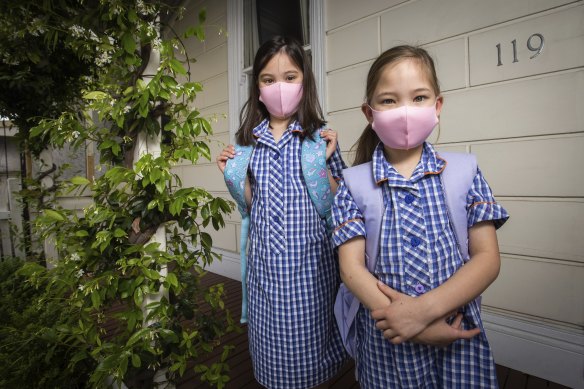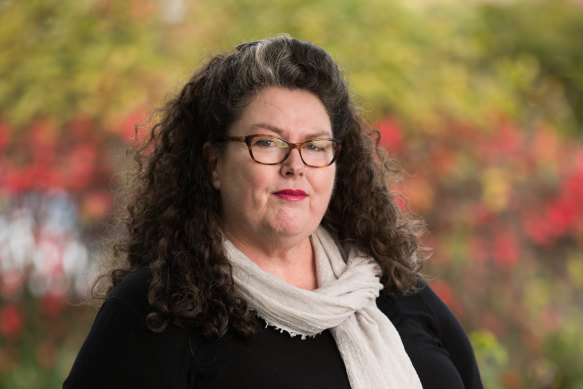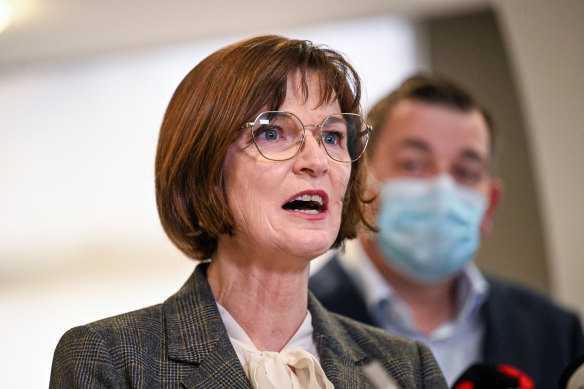By Ashleigh McMillan and Timna Jacks
Several leading epidemiologists have questioned the Victorian government’s stronger stance on mask-wearing in schools, saying it would deliver marginal benefit at a significant cost to children’s learning.
Students aged eight and over are now “expected” to wear masks indoors as part of new Department of Education guidelines.

Some experts do not believe the marginal reward of students wearing masks in class is worth the cost.Credit: Paul Jeffers
Changes were made overnight to the department’s school operational guide, stating it was the department’s expectation that students aged eight and over would wear masks when in class until the end of winter. The guide notes that schools are not “required or expected to sanction students or staff” who fail to meet the expectation around masks.
A letter outlining the change – signed by the heads of the state, independent and Catholic education sectors – was sent to state schools late on Monday, stating it was “strongly recommended” that students aged eight and over wear masks when indoors.
Acting chief health officer Ben Cowie had recommended the return of mask-wearing for early childhood and school settings, as well as in shops and some hospitality settings for workers, in recent advice to the state government. However, Health Minister Mary-Anne Thomas rejected that advice at the time, in favour of letting the public “take control of their own health”.
The letter sent to schools and addressed to parents said: “We are asking for your support in explaining to your child or children the importance of this simple step that will help keep our schools as safe as possible.”
“We all appreciate how important it is for students to be back at school. This action will help make sure as many students and staff as possible are protected from COVID and other winter illness.”
Australian National University infectious disease expert Peter Collignon said the measure would deliver some benefit, with masks providing 15 per cent protection from infection.
But the overall benefits would be small, given that when children get sick with COVID-19, they are at low risk of severe illness, he said.
“It’s a fallacy that children are a major way that COVID spreads,” Collignon said.
“That’s true for influenza – they have a four or five times higher rate of infection than adults. But that’s not true for COVID. For COVID, it’s 20 to 40-year-olds – their parents – who have always had it more often than their children.“
Chair of epidemiology at Deakin University Catherine Bennett said the cost of mask-wearing to students’ learning would be significant, and the intervention should be grounded in good quality research.
“What evidence do they have to encourage schools to go this path? It might make a small difference, but is that small difference going to be worth the impact on kids’ education?”
Bennett said she was sceptical about the quality of modelling underpinning the policy and called for it to be made public.

Catherine Bennett, chair of epidemiology at Deakin University, wants the modelling of mask-wearing in schools made public.Credit: Jason South
The nature of the current outbreak was difficult to track, she said, given the mix of different variants and risk of reinfection in an “immune-escape environment”.
“It’s a whole different disease dynamic, and it’s still being treated as the same sort of growth rate,” she said.
Melbourne University epidemiologist Tony Blakely said mask-wearing in schools was a sensible measure to help flatten the curve and prevent hospitals from being overrun.
“The peak, if we do nothing, is going to go above what our health services can manage, so we need to dampen it,” he said.
However, he agreed with Collignon and Bennett that a classic cost-benefit analysis showed the benefits were marginal compared with the costs to schools and students.
Both Thomas and Education Minister Natalie Hutchins said the altered messaging on mask-wearing on Monday night was “not a change in policy” but rather an attempt to ensure families were aware of the health minister’s recommendations as respiratory illness cases increase in Victoria.
“I think the messages have been clear and they’ve been very well taken up by the education system,” Thomas said.
Independent School Victoria recommended to its member schools last week that masks be worn in the classroom.
School staff are also expected to wear masks except in “teaching circumstances when clear communication” is needed.
School Principals Association president Andrew Dalgleish said he had “absolutely no idea” how many children would be wearing masks in classrooms by Wednesday.
“As you’ve seen this morning, we’re caught in a catch-22 situation,” he told 3AW’s breakfast radio show.
“When masks were mandated last year, people were up in arms. While it’s not a mandate, people are saying, ‘well we shouldn’t be forcing the wearing of masks’. But we’re not; we’re actively encouraging people to take an action that we know will minimise the spread of this disease [COVID-19].”
The advice came as Thomas reiterated it was “strongly recommended” people wear masks indoors and in crowded places, but said there would be no mandate.
On Tuesday, Thomas told ABC’s Mornings With Virginia Trioli that the state government needed to give parents the “information to make their own decision”.
“The best tool is information. We need to take our time and continue to educate and explain to those parents who are concerned about mask-wearing why it works,” she said.
“What I have seen is an additional take-up of mask-wearing over the past week or so, as people are informing themselves and learning about the current wave of the Omicron virus.”

Victorian Health Minister Mary-Anne Thomas denies the updated recommendations are a change in policy.Credit: Joe Armao
She said the heads of Victoria’s school systems decided to send the letter to parents and were not directed to do so by the Department of Education.
Blakely said he would strongly support the same messaging for workplaces and lambasted state and federal governments as “missing in action” due to their lack of public health messaging recently and of enforcement of mask-wearing on public transport.
Victorian Opposition Leader Matthew Guy said the school mask advice had created “total confusion” and there should have been a health awareness campaign on COVID-19 before the predicted Omicron wave hit.
“One minute they say there are no mandates, and the next minute they’re advising kids to wear masks. What is it?” he said.
“If we were going to have problems over winter – and we knew there would be – then why not have a campaign around COVID safety before winter.”
The Morning Edition newsletter is our guide to the day’s most important and interesting stories, analysis and insights. Sign up here.